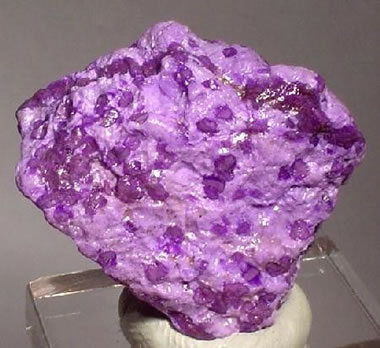
Sugilite: Massive pinkish-purple sugilite containing numerous purple sugilite microcrystals. This specimen measures 3.0 x 2.8 x 1.3 centimeters and is from the Wessels Mine, Northern Cape Province, South Africa. Specimen and photo by Arkenstone / www.iRocks.com.
What Is Sugilite?
Sugilite is a rare mineral and a gemstone best known for its vibrant pink to purple colors. High-quality specimens are sought after by mineral collectors and lapidarists (people who cut and polish gems).
Sugilite is a sodium potassium lithium silicate mineral. Small amounts of manganese produce the pink to purple color displayed by some specimens of sugilite. Its chemical composition is as follows:
KNa2(Fe,Mn,Al)2Li3Si12O30
The composition of sugilite varies because iron, manganese, and aluminum can substitute for one another. This makes the color and other properties of sugilite variable.
Table of Contents
 What Is Sugilite? What Is Sugilite? Sugilite Gemology Sugilite Gemology Imitation Sugilite Imitation Sugilite Geologic Occurrence of Sugilite Geologic Occurrence of Sugilite Buying Sugilite Buying Sugilite |
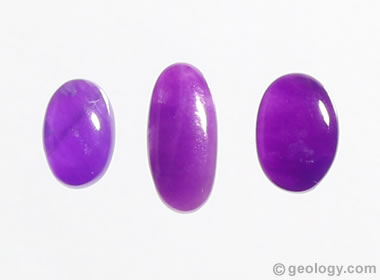
Sugilite Cabochons: Three small cabochons of translucent sugilite with a wonderful purple color. They are a grade of sugilite that is often described as "gel sugilite". The cab in the center measures approximately 5 x 10 millimeters.
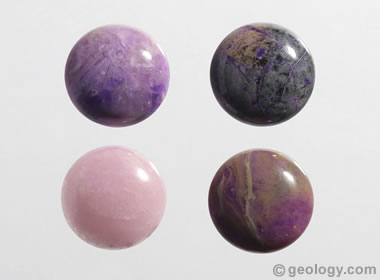
Impure Sugilite: Sugilite often occurs in rocks composed of many minerals. These cabochons are a combination of sugilite, chalcedony, and other minerals. Impure sugilite can make attractive cabochons that should sell for prices much lower than solid sugilite - unless they have a color and appearance that merits the price, which these cabochons do not have. Each cab measures 20 millimeters across.
Sugilite Gemology
Sugilite was first discovered in 1944. It did not enter the gem and jewelry market until 1979, after commercial quantities of gemstone-quality sugilite were found at the Wessels Mine in South Africa. [1]
Very few jewelry consumers are familiar with sugilite. Why? Because it is a rare mineral, only available in small quantities, has a short commercial history, and has never been heavily promoted.
Cabochons, beads, and small sculptures are the most common items made from sugilite. With a Mohs hardness of 5.5 to 6.5, sugilite is best used in pendants, earrings, brooches and other items that are not exposed to abrasion or impact. When used in rings and bracelets, sugilite should be in a mounting that protects it from damage, and the owner should be aware of the fact that it is a fragile gemstone.
The best pieces of solid sugilite are usually found in one-of-a-kind jewelry items. However, increasing amounts of sugilite are starting to appear in the sterling silver and turquoise jewelry that is popular in the southwestern United States. It is often used in inlay designs and as small secondary stones.
Some of the most impressive items made using sugilite are small boxes, desk sets, trays, and jewelry decorated with intarsia designs. The purple color of sugilite creates wonderful color combinations with malachite, turquoise, lapis lazuli, and opal. An article in Gems & Gemology shows nice examples of these projects. [2]
Pieces of sugilite that are too small to cut or below cutting grade are often crushed, mixed with resin, and cast into blocks. The blocks are then cut into slabs and used to cut beads and cabochons. "Block turquoise" is made by a similar process.
Much of the material that is called "sugilite" and used to make jewelry is a natural mixture of sugilite and other minerals, sometimes with sugilite being a minor ingredient. In rocks near where sugilite is found, purple chalcedony with suspended particles of sugilite is sometimes found. This material can be beautiful and is similar to gem silica.
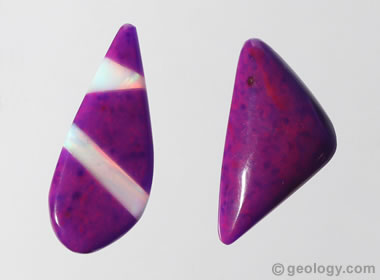
Imitation Sugilite: The purple material in these cabochons is made of powdered sugilite that has been pressed into a mold and bound together by resin. The cabochon on the left is an assembled stone made by artistically combining imitation sugilite and imitation opal. The cab on the left measures 20 x 50 millimeters, and the cab on the right measures 23 x 45 millimeters.
Imitation Sugilite
Imitation sugilite and composite materials made to imitate sugilite are abundant in the marketplace. These items are often sold without disclosure. Much imitation sugilite is also labeled as "synthetic". It is likely that sellers are unaware of what they are selling.
The Gemological Institute of America reports that dyed marble [3] and dyed quartzite [4] have been used as sugilite imitations. GIA also reported on purple beads that were a convincing imitation of sugilite. Advanced testing of the beads revealed that they were made from dyed serpentine [5].
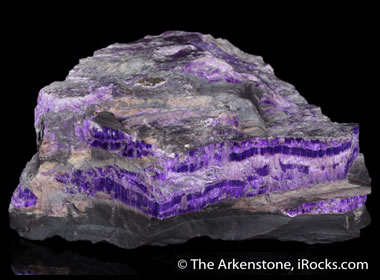
Fibrous Sugilite: A specimen of gray-black manganese-bearing shale from the Kalahari Manganese Field that contains bands of fibrous sugilite. The fibrous portions of the bands produce chatoyant reflections. This specimen measures 11.2 x 10.9 x 4.7 centimeters and is from the N'Chwaning III Mine, North Cape Province, South Africa. Specimen and photo by Arkenstone / www.iRocks.com.
Geologic Occurrence of Sugilite
Sugilite occurs in only a few locations worldwide. Production of gem-quality sugilite only occurs in noteworthy amounts from the stratiform manganese deposits in South Africa. Sugilite is also found in small amounts as a primary mineral in igneous rocks and as a secondary mineral in marble.
Manganese deposits similar to those of South Africa exist in other countries (India, Brazil, Ghana, and Russia), but none of these deposits are known to be commercial producers of sugilite.
Sugilite was first discovered in 1944 in a small stock on Iwagi Islet, Southwest Japan by Japanese geologists Ken-ichi Sugi and M. Kutsuna. They did not identify the mineral, but described it as an eudialyte-like mineral based upon its optical properties.
At the Iwagi Islet locality, sugilite occurred in an aegirine syenite, and accounted for 3% to 8% of the rock's volume.
In 1976, Nobuhide Murakami and others published the first detailed description of the mineral's chemistry and structure. They posthumously named the mineral "sugilite" to honor to Ken-ichi Sugi (1901-1948). [6]
Today most sugilite entering the market as gem rough or mineral specimens is from a few mines in the Kalahari Manganese Field, North Cape Province, South Africa. Gem material from the Wessels Mine has been marketed under various names that include Lavulite and Royal Azel. [1]
Sugilite is also found near Mont St. Hilaire, Canada; Faggiona, Italy; New South Wales, Australia; and, the Madhya Pradesh state of central India. [7] [8]

Imitation Sugilite: A block of imitation sugilite made from a resin composite. This specimen measures approximately 9.8 x 4.8 x 3.5 centimeters.
Buying Sugilite
A person interested in purchasing sugilite jewelry, loose stones, or cutting rough should be very familiar with the material. The conditions of the gem that they might encounter are listed below:
Physical Properties of Sugilite |
|
| Chemical Classification | Silicate |
| Color | Gem-quality specimens are pink to reddish purple to purple. Impure specimens are often yellow, brown, purplish brown, grayish purple, or black. |
| Streak | White |
| Luster | Dull, waxy, vitreous |
| Diaphaneity | Usually translucent, sometimes opaque |
| Cleavage | Poor to indistinct, rarely observed. Usually occurs in massive granular aggregates. |
| Mohs Hardness | 5.5 to 6.5 |
| Specific Gravity | 2.7 to 2.8, varying with impurities |
| Diagnostic Properties | Color, luster, specific gravity. Can be difficult to identify without advanced methods. |
| Chemical Composition | KNa2(Fe,Mn,Al)2Li3Si12O30 |
| Crystal System | Hexagonal |
| Uses | Pieces with outstanding color are used as gemstones. Excellent specimens, especially specimens with well-formed crystals, are of interest to mineral collectors and may be more valuable than gem rough. |
| Sugilite Information |
|
[1] The Occurrence and Gemological Properties of Wessels Mine Sugilite: by James E. Shigley, John I. Koivula, and C. W. Fryer; an article in Gems & Gemology, Volume 23, Number 2, pages 78 to 89, Summer 1987.
[2] Contemporary Intarsia: The Medvedev Approach to Gem Inlay: by James Elliott, an article in Gems and Gemology, Volume 22 Number 4, pages 229 to 234, Winter 1986. [3] Dyed Marble as a Purple Sugilite Imitation: by Ke Yin and Shan-shan Du, an article in Gems & Gemology, Volume 50, Number 4, Winter 2014. [4] Quartzite Dyed to Imitate Sugilite: a Lab Note in Gems & Gemology, Volume 34, Number 2, Summer 1998. [5] Dyed Serpentine Imitating Sugilite: by Jessa Rizzo, a Lab Note in Gems & Gemology, Volume 55, Number 2, Summer 2019. [6] Sugilite, A New Silicate Mineral From Iwagi Islet, Southwest Japan: by Nobuhide Murakami, Toshio Kato, Yasunori Miura and Fumitoshi Hirowatari; an article in Mineralogical Journal, Volume 8, Number 2, pages 110-121, April 1976. [7] Sugilite: Mineral Information, Data, and Localities: an information page published on the Mindat.org website; accessed February 2020. [8] Smithsonian Rock and Gem: by Ronald Louis Bonewitz, a joint publication by Dorling Kindersley and the Smithsonian Institution, 360 pages, 2008. |
1) Natural sugilite: This is a naturally occurring material that consists entirely of natural sugilite. Attractive pieces of this material should sell for the highest prices, with an attractive, uniform color being an important element of value. This material is the choice of a person who wants to purchase a wonderful product of nature.
2) A natural mixture of sugilite and other minerals: This is a naturally occurring rock made up of sugilite and other minerals. These materials can be attractive and desirable. Their color, pattern and appearance are important elements of value, but these items will sell for a lower price than equally attractive items comprised entirely of natural sugilite.
3) A man-made composite of crushed sugilite and resin (block sugilite): This is a man-made material that might be especially attractive, with color enhancement done by people being likely. Attractive pieces of this material should sell for significantly lower prices than natural sugilite of similar color and appearance. Buy this if you like sugilite, if you like the appearance of the piece, and if you are satisfied with an item that is made from crushed sugilite bound together with resin, and probably color-enhanced by people. This is what you will likely receive if you are buying at the lower end of the sugilite price range. Some buyers absolutely do not want this material. They want naturally-formed sugilite. But, there is nothing wrong with buying this product if you like it and your seller discloses what you are buying. Unfortunately, some sellers label this material as "sugilite" and do not know or choose to disclose its true nature.
4) A natural material that is not sugilite, but has been dyed and treated to be a sugilite look-alike. The top of this article cites reports from the Gemological Institute of America about people making sugilite look-alikes by dying marble, serpentine and quartzite. There is nothing wrong with buying these as long as you know that you are not buying sugilite, and the seller is not telling you that the item is natural sugilite.
5) A man-made material that contains no sugilite: This is a man-made material produced with the goal of being a sugilite look-alike. It could be made from ceramic, plastic, glass, or another material. It is an imitation sugilite that should sell for a significantly lower price than similar-looking items from the categories above. There is nothing natural in this material, but if you like it there is nothing wrong with buying it. The problem occurs when the seller fails to disclose that it is a man-made imitation and is simply promoting it as "sugilite".
Buy with caution. On the basis of "sight" alone, it can be difficult to impossible to tell the difference between sugilite, rocks containing abundant sugilite, block sugilite, and some of the dyed and imitation materials. Microscopy, spectroscopy, specific gravity determination, and refractive index testing can help separate sugilite from many of its look-alikes. If you are spending serious money on a sugilite item, you should have its identity confirmed by gemological laboratory.
| More Minerals |
 |
Herkimer Diamonds |
 |
The Acid Test |
 |
Tumbled Stones |
 |
Zircon |
 |
Fool*s Gold |
 |
Kyanite |
 |
Rock Tumblers |
 |
Rhodochrosite |

Find Other Topics on Geology.com:

|

| ||

|

| ||

|

| ||

|

|
